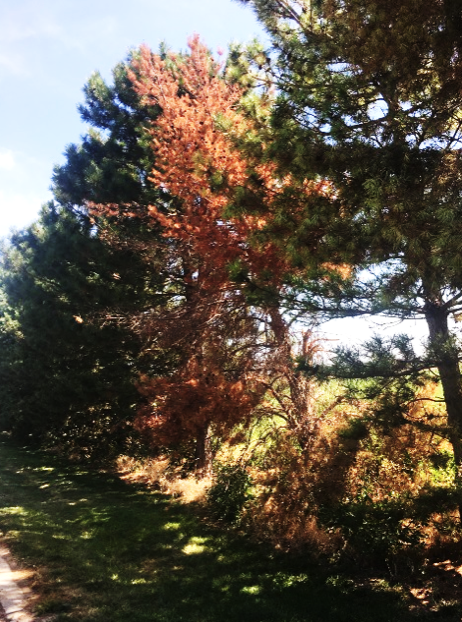 “You can’t live with them, but you can’t live without them.” This is often what I hear from homeowners when referring to their pine trees.
“You can’t live with them, but you can’t live without them.” This is often what I hear from homeowners when referring to their pine trees.
The needle and pine cone clean-up is monotonous, but the aesthetic they can provide for a lawn or break from the wind makes it all worth it. This summer our Pines have struggled to stay alive because we have gone from one extreme (rain) to another (hot temps). Now to add to that mix, I am starting to see a lot of pine trees fall to Pine Wilt. This is not a new disease to Western Kansas, but some may think it went “dormant” over the last several years because we haven’t seen it as often. If you are unfamiliar with Pine Wilt I have provided adequate information about the disease below including how to prevent the disease.
Pine Wilt is a very serious disease that is considered to be a problem in Scots pine trees in landscape settings, windbreaks, Christmas tree farms, and recreational plantings. Pine wilt has also been reported on Austrian and white pines.
In Kansas, the symptoms for pine wilt usually appear from August through December. In general, the trees wilt and die rapidly within a short period of time. Occasionally, trees may survive for more than one year. The needles turn yellow/brown and remain attached to the tree. The early stages of the disease are subtle and may vary. The pinewood nematode is transmitted from pine to pine by a bark beetle, the pine sawyer beetle.
Needles initially show a light grayish-green discoloration, then turn yellow and brown. The disease may progress uniformly through a tree or branch by branch, depending upon the size of the tree and the environmental conditions during the growing season. The needles remain attached for up to six to twelve months after the tree has died. The rapid death of a tree contrasts with other pine problems such as fungal diseases, insects, or environmental stresses.
There is one option to potentially save unaffected Scots, Austrian, and white pine trees from Pine Wilt. According to Colorado Extension two compounds are labeled for the prevention of pine wilt. These products are directed towards killing/immobilizing the nematode and not for killing the pine sawyer beetle vector. They are not effective if the tree is symptomatic or once the PWN has colonized the tree. Several commercial injection systems are available, but pine injections are almost always done by professional arborists. Yearly injections provide the greatest protection, but the cost and potential damage associated with the injection process are issues to consider.
It is important to confirm the presence of the pinewood nematode if pine wilt is suspected to be the cause of a tree death. Early confirmation will allow the owner to act quickly to prevent the spread of the pinewood nematode to nearby pine trees. In established pine plantings such as landscape settings, windbreaks, and Christmas tree farms, the only control measure is to remove affected trees and burn, bury or chip the wood before April 1. Trees should be removed to ground level. No stumps should be left. This prevents further spread of the nematode and its vector before they emerge from the trees in the spring.
If you have further questions regarding Pine Wilt please reach out to Lauren Walz, the Cottonwood District Horticulture Extension agent by calling 785-628-9430 or by e-mail [email protected]

